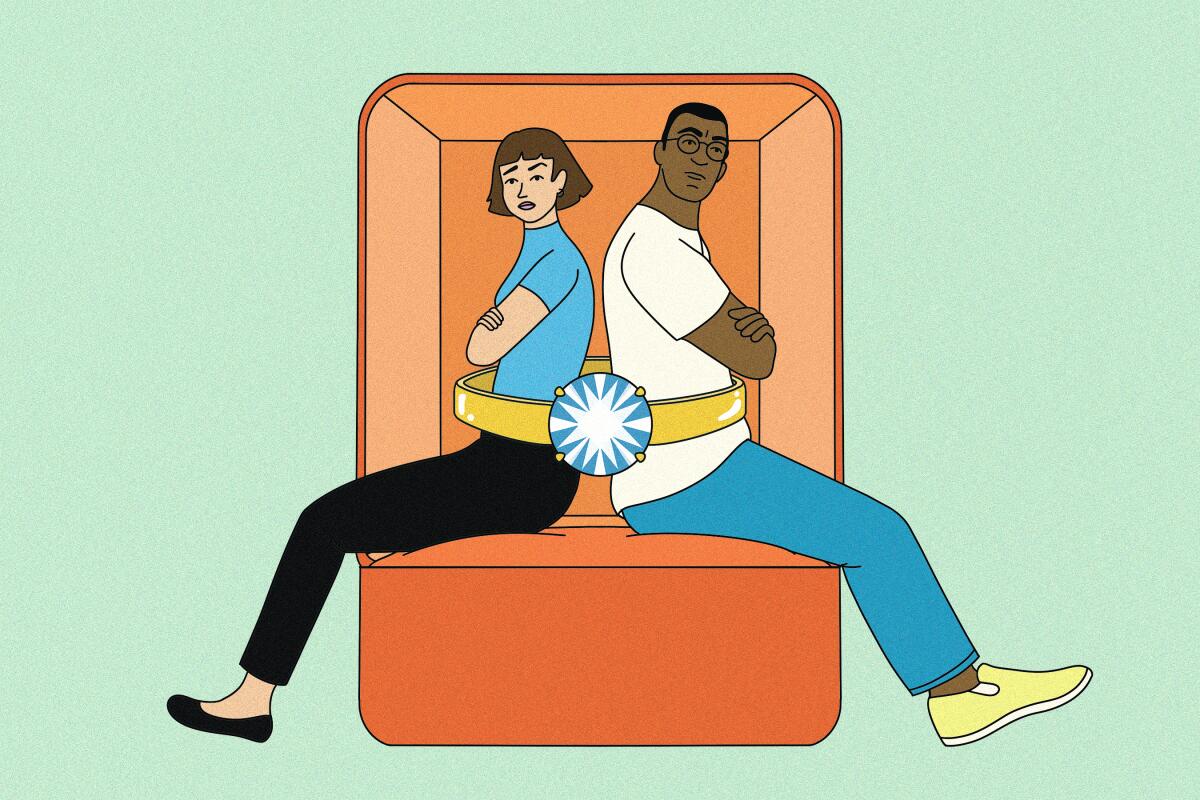Opinion: Does it matter if a man or a woman proposes?

- Share via
Over 20 years ago, I covered my face with my hands and shyly told my (now) husband, “I’m moving away for graduate school and I’d love you to go with me, but I want us to be married first.”
After he agreed that it seemed like a great idea, we shopped for an engagement ring before he chose one of the two I had liked best. He offered it to me from one knee a couple of months later in a “surprise” engagement. As a wife, I tell others he proposed. But as a social scientist who studies marriages and engagements, I’m not so sure.
Young, heterosexual adults increasingly prefer egalitarian relationships in which both partners work for pay and contribute equitably to child care and domestic labor, even as they struggle to realize this balance. Equalizing the proposal — a single moment in time rather than an ever-changing, lifetime negotiation of labor — should be much easier.
Still, the proposal process remains overwhelmingly a male responsibility — and privilege. The stubbornness of this seemingly last acceptable bastion of male control has a lot to tell us about gender, relationships and the division of labor in 21st century America.
Sharon Sassler, a sociology professor at Cornell, and I interviewed a number of cohabiting couples between the ages of 18 and 34 who were considering or in the process of discussing marriage with their partners. We explicitly asked them which partner should propose. We received a fair number of responses along the lines of “whomever wants,” especially from college-educated men and women.
But when we changed the question slightly to, “Who do YOU want to propose if the two of you get married?” the response was overwhelmingly the male partner. And this remained true even among those who otherwise viewed their relationships as equal.
When we asked why, men and women alike expressed concerns that “flopping the question” would call into question long-established gender roles. “It’s just a manly job,” explained T., a male respondent. “It’s just natural.”
N. was another man who felt the same way. He had just proposed and was committed to sharing the housework and financial responsibilities equally with his female partner, A. Although A. had been the one to initiate their move-in, he said of the wedding proposal: “I think it’s the guy’s job, not to be chauvinistic and old-fashioned. But I think I would have felt kind of like a putz if she would have proposed to me.”
Many women agree. One woman, T., told us: “I said, ‘If you don’t do it by a certain time, I’m just going to do it.’ But I don’t mean that, because I don’t want to do it ’cause then I’ll feel like masculine, and I don’t want to feel masculine.” Asked to elaborate, she said, “I’ve definitely been the initiator in some of our other circumstances that are traditionally I think male roles. This is just a big one. And because everyone will ask, ‘How did it happen?’ And I don’t want to say, ‘Well, I did it.’ I can’t. It would kill me, I think.”
Female proposals were not entirely out of the question. D. was one woman who had planned to propose to her male partner, J., only to be dissuaded by both her mother and J. She said, “I’ve threatened to propose to him a few times. He’s like, ‘No, the man does it.’ I think he would feel unmanly if he didn’t do it. Yeah, I know that sounds weird from a guy that’s really liberal, but I just feel like he wants to — he wants control of the situation.” J.’s explanation was simpler: “I just see it as the guy should propose — the classic way.”
All of this, for one simple question. But the power to propose is not merely picking out the right place or time to ask those four little words. It’s the ability to determine the pace of the entire relationship. It stands to reason that if the male partner is the only one who can move the couple’s union into marriage, the female partner has only two choices: wait to be asked or leave.
In this way, the man’s timeline determines the seriousness of the relationship, with couples often scarcely realizing just how much control that gives him. In fact, this kind of “hidden power,” which makes certain gender roles seem natural or inevitable, can continually and insidiously reinforce patriarchal norms without ever really being questioned.
So what’s a modern straight couple to do? What might a more equal proposal look like?
Well, for one, heterosexual cis couples could certainly look to their gay and lesbian counterparts, who often leave the power of the proposal to a decision reached through discussion or to the partner who most wants to advance the relationship. Such a change would require couples to push aside centuries of tradition and internalized sexism.
More recently, “dual proposals” have begun to show up on social media. In this model, each partner proposes, and each accepts. Though, of course, this is not without its own challenges: Need the proposals occur on the same day? Who goes first? And is the engagement official after the first “yes”?
As the age of marriage has risen over time in the U.S. to just over 30 for men and 28 for women, the institution has become more economically elite. Committed couples now typically have established their own households, with three-quarters living together before marriage.
After discussing whether they wish to marry, couples could simply decide that they are engaged, no proposal needed. By now, the marriage proposal ritual as a male prerogative should feel as archaic as the idea of “giving away” the bride.
Amanda Jayne Miller is a professor of sociology and director of faculty development at the University of Indianapolis and an OpEd Project Public Voices fellow. She is the co-author of “Cohabitation Nation: Gender, Class, and the Remaking of Relationships.” This article was produced in partnership with Zócalo Public Square.
More to Read
A cure for the common opinion
Get thought-provoking perspectives with our weekly newsletter.
You may occasionally receive promotional content from the Los Angeles Times.










